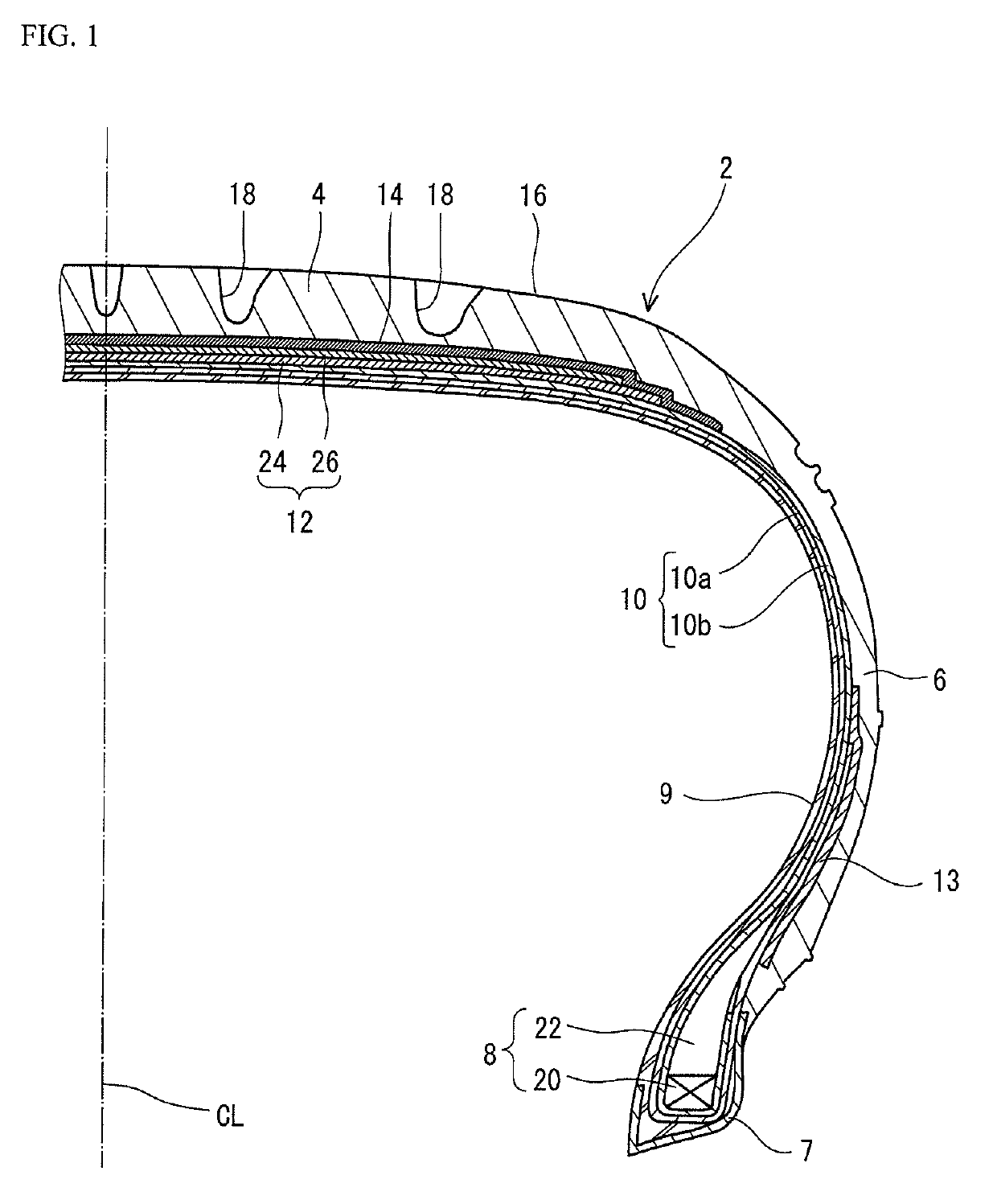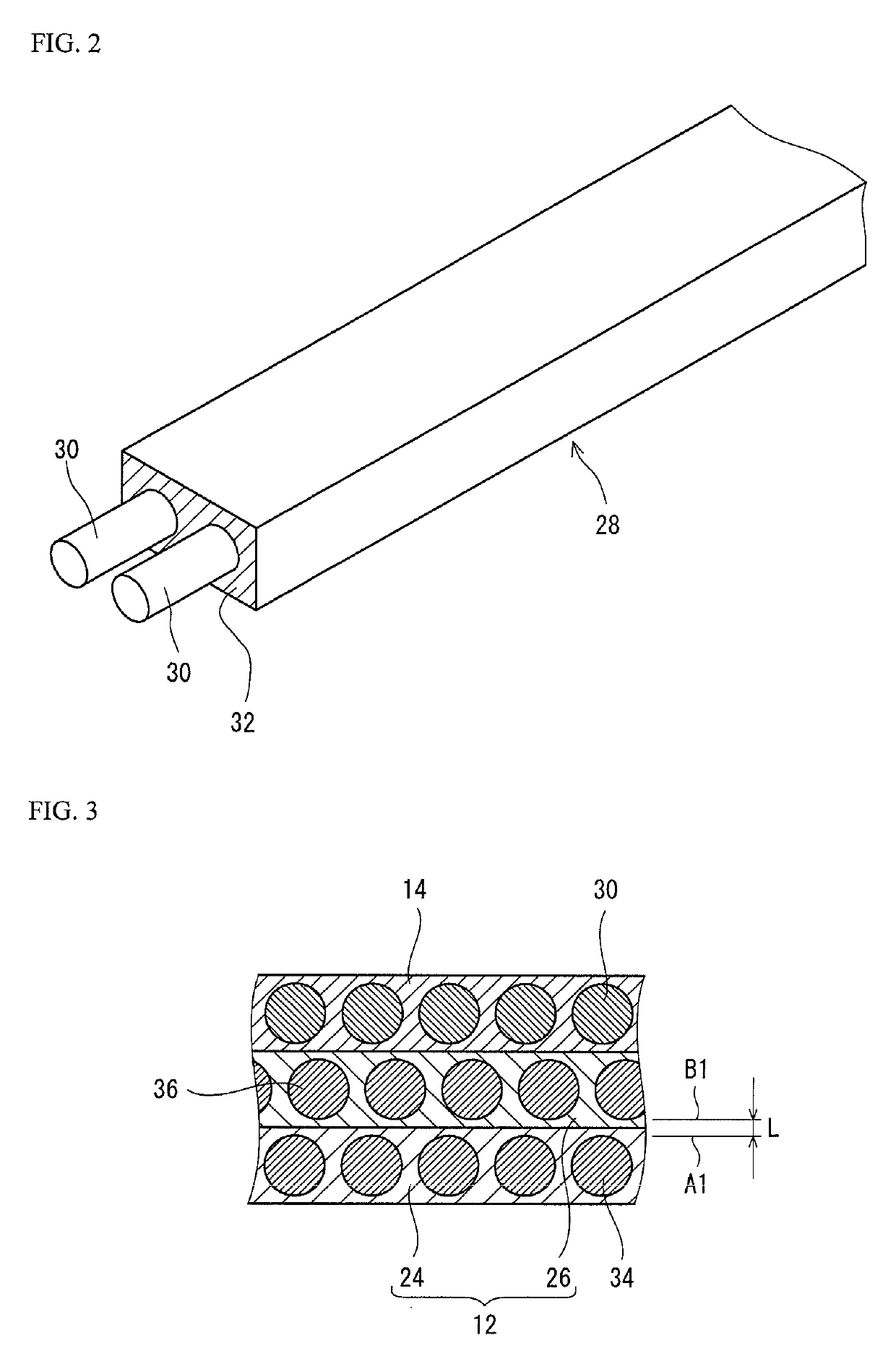Tire
a technology of rubber and elongation, applied in the field of tires, can solve the problems of increased noise in the actual situation, inability to exhibit excellent low fuel consumption performance, etc., and achieve the effects of reducing the durability reducing the complex elastic modulus and the elongation at break of the rubber composition, and reducing the adhesion to the polyester cord
- Summary
- Abstract
- Description
- Claims
- Application Information
AI Technical Summary
Benefits of technology
Problems solved by technology
Method used
Image
Examples
embodiment
[0063]One example of an embodiment of the tire according to the present disclosure will be described in detail with reference to the drawings. FIG. 1 shows a pneumatic tire 2. In FIG. 1, the up-down direction is the radial direction of the tire 2, the right-left direction is the rotation axis direction of the tire 2, and the direction perpendicular to the surface of the sheet is the circumferential direction of the tire 2. In FIG. 1, an alternate long and short dash line CL represents the equator plane of the tire 2. The shape of the tire 2 is symmetrical about the equator plane CL except for a tread pattern.
[0064]The tire 2 includes a tread 4, a pair of sidewalls 6, a pair of chafers 7, a pair of beads 8, an inner liner 9, a carcass 10, a belt 12, a pair of fillers 13, and a jointless band 14. The tire 2 is of a tubeless type. The tire 2 is mounted to a passenger car.
[0065]The tread 4 has a shape projecting outward in the radial direction. The tread 4 forms a tread surface 16 that ...
example 1
[0093]First, a band in which a rubber composition was in an uncrosslinked state was formed through the following procedure.
[0094]An adhesive composition was prepared as a first treatment agent by adding 11.8 g of ETC-N615 (sorbitol polyglycidyl ether, chlorine content: 9.3% by weight, epoxy equivalent: 163, manufactured by Nagase ChemteX Corporation) as an epoxy compound to 920 g of water while stirring the water, and adding 72.1 g of an s-caprolactam blocked diphenylmethane diisocyanate aqueous dispersion (54% concentration) as a blocked isocyanate thereto.
[0095]An RFL liquid was prepared as a rubber latex by diluting 172 g of Nipol 2518FS (manufactured by Zeon Corporation, a vinylpyridine-styrene-butadiene terpolymer aqueous emulsified liquid, total solid content concentration: 40.5%) and 73 g of Nipol LX-112 (manufactured by Zeon Corporation, a styrene-butadiene copolymer 41% aqueous emulsified liquid, total solid content concentration: 40.5%) with 76 g of water, and adding 270 g...
example 2
[0112]A tire was produced in the same manner as Example 1, except the amount of a rubber to be attached to cords and an expansion rate of a raw cover during molding and vulcanization were adjusted such that the gauge between the cords of two adjacent layers in an obtained tire was 0.35 mm. The obtained tire was evaluated for the gauge between the cords of two adjacent layers in the belt, road noise, and rolling resistance. The results are shown in Table 1.
PUM
| Property | Measurement | Unit |
|---|---|---|
| temperature | aaaaa | aaaaa |
| nitrogen adsorption specific surface area | aaaaa | aaaaa |
| nitrogen adsorption specific surface area | aaaaa | aaaaa |
Abstract
Description
Claims
Application Information
 Login to View More
Login to View More - R&D
- Intellectual Property
- Life Sciences
- Materials
- Tech Scout
- Unparalleled Data Quality
- Higher Quality Content
- 60% Fewer Hallucinations
Browse by: Latest US Patents, China's latest patents, Technical Efficacy Thesaurus, Application Domain, Technology Topic, Popular Technical Reports.
© 2025 PatSnap. All rights reserved.Legal|Privacy policy|Modern Slavery Act Transparency Statement|Sitemap|About US| Contact US: help@patsnap.com


